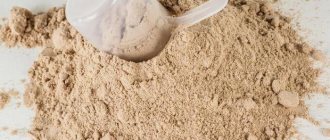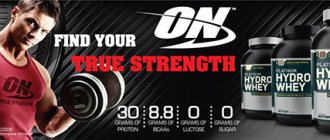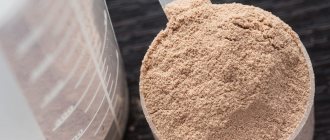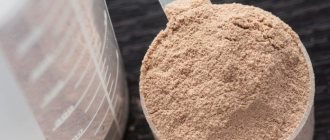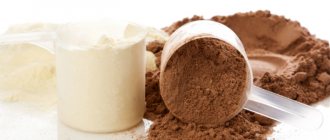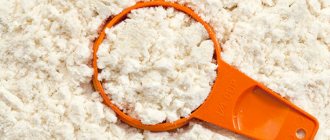Share:
Protein concentrate is a sports supplement containing purified protein. It comes in various origins: egg, whey, plant (including soy) animal. There are no artificially synthesized concentrated proteins.
Whey concentrate is the most popular and most commonly used form of protein, which is used in sports to build muscle mass and during the cutting period to accelerate weight loss. Many athletes take the supplement periodically to maintain good shape.
What is whey concentrate
Whey protein is a source of purified protein. It is completely absorbed and consumed by the body.
Protein is used for the following purposes:
- building muscle mass;
- protein compensation during a mono-diet;
- minimizing the loss of muscle tissue during drying;
- maintaining shape and relief during training.
Protein mixtures are in demand among professional bodybuilders, weightlifters, and just sports fans. The nutritional supplement is suitable for both male and female bodies.
Admission rules
Each manufacturer calculates the dosage of the supplement in its own way, but the optimal portion is considered to be 30 g of pure protein per dose. A larger amount may simply not be absorbed and have a negative impact on the liver.
It is recommended to take one to three servings per day.
If a person is accustomed to consuming small amounts of protein in food, then he should not start taking protein concentrate with large doses. The eating style needs to be changed gradually, evenly increasing portions.
If a beginner who wants to quickly build muscle or lose weight starts with large doses, he may develop adverse reactions, problems with the gastrointestinal tract and liver. The body cannot absorb more protein than it is used to.
https://youtu.be/j7llZUfmWjE
The concentrate is taken by diluting it with any liquid. If an athlete needs to dry out, it is recommended to use plain water or low-fat dairy products. If the supplement is taken for the purpose of building muscle mass, it is better to dilute the product in juices and dairy products with normal fat content.
Composition, what it is made from
Protein is the basis of any protein supplement. One serving contains on average 25 g of protein, 4 g of carbohydrates, 2 g of fat, 400 mg of nutrients (potassium, sodium, calcium, cholesterol).
The basic components of the mixture always remain the same. Manufacturers can change the quantitative composition of microelements, add vitamins, natural or synthetic flavors.
The mixture is obtained from filtered whey. The concentrate production process can be reflected in the form of a diagram:
When milk is fermented, the curds are separated. It retains the bulk of milk protein (or casein). The remaining liquid is whey, which serves as the basis for protein.
The resulting solution is heated at a temperature of 72 degrees. The consistency goes through several stages of filtration and drying. The output is protein, ready for consumption. To improve the taste of the powder, the manufacturer adds flavorings and sweeteners.
Whey mixture is not only produced as a concentrate. Further processing of the product makes it possible to obtain a higher quality protein, practically free of fats and carbohydrates - isolate. The highest degree of processing is hydrolyzate. The product contains 99% pure protein. The disadvantages are the high price and unpleasant taste.
Casein food
Casein is a traditional product of the dairy industry. In the past, it was widely used for technical purposes, including as glue for aircraft (the period of the Great Patriotic War 1941-1945). Currently, in the future, we use this most valuable natural protein of raw milk exclusively for food purposes. One of the conditions for this is the high quality of food grade products. To ensure this, modern technology and expertise are required.
Production technology. The essence of the technology for producing casein is to ensure acid or rennet coagulation of milk proteins of this fraction, followed by separation of the sediment, its washing, dehydration and drying. The technology for producing casein is shown in Figure 1.
Figure 1 - Casein production diagram
Skim milk with an acidity of no higher than 21 °T and a fat content of no more than 0.05% is subjected to mandatory heat treatment - pasteurization at 72-74 °C for 15-20 s and cooled to 30-39 °C. If it is necessary to store skim milk, it is cooled to 6-8 °C. Skim milk is heated before use.
Coagulation (precipitation) of casein is carried out with rennet, hydrochloric acid, fermentation or the addition of acid whey mixed with the enzyme.
Precipitation of casein with rennet is carried out similarly to the production of cheese: adding an enzyme solution and allowing the mixture to coagulate (form a clot).
Precipitation of casein with hydrochloric acid (1 M solution) is carried out at a temperature of 37 ± 2 ° C with continuous stirring of skim milk or in a stream with the pH adjusted to 4.4-4.2, which corresponds to a titratable acidity of 48-53 ° T. The acidified mass is kneaded (or kept in a stream) for 3-5 minutes to obtain homogeneous grain.
Precipitation of casein with lactic acid is carried out by fermentation or adding acid whey with an enzyme.
Fermentation is carried out at a temperature of 30-32 °C in winter and 28-30 °C in summer with a starter specially prepared with skim milk. The starter is added in an amount of 1-5%, the duration of ripening is 8-12 hours. The readiness of the curd is determined by the acidity, which should be 80-90 °T. The finished curd is cut into cubes about 2 cm in size along the edge.
When casein is precipitated with pre-prepared (fermented) acid whey with an acidity of at least 230 °T and added with a working solution of the enzyme preparation amyloresin P10X (30 g/t) or food grade pork or beef pepsin (4 g/t), previously diluted in a small amount amount of whey, the process is carried out in a flow using a dosing device on the “Ya9-OKL” line. The coagulant consumption is approximately 25-30% of the mass of processed skim milk.
The resulting casein grain is subjected to heat treatment in a container by heating to 60 °C for up to 10 minutes or in a stream at 72 ± 2 °C for 15-20 s. The delivered grain, after heating and drying, has a size of 3-5 mm; it is separated from the whey by settling or in flow on the Ya9-OKL line with a RZ-00 K1 dehydrator and cooled to 42 ± 5 ° C. Casein is washed with tap water to remove ballast substances. The number of washes and the volume of water used determines the quality of the finished product. In practice, they use 2-3 times washing with reuse of water to save it. The water temperature during washing decreases from 35-40 °C for the first to 10-15 °C for the third flush. The volume of wash water is 25-30% of the volume of processed skim milk (total consumption 60-80%). The duration of contact between water and grain is 15-20 minutes with continuous stirring. To separate casein grains from wash waters, it is recommended to use a whey separator or a device from the Ya9-OKL line.
Dehydration of casein with a moisture content of 80% to 60-62% is carried out by centrifugation, pressing or on a dehydrator “RZ-00K1” of the “Ya9-OKL” line.
Before drying, raw casein is ground on grinders or special granulators to a particle size of 4 mm. Drying casein without prior crushing is strictly prohibited. Casein is dried in special periodic or continuous dryers such as “VS-150 KPP”, “Ulyra-2S”, etc., which prevent a decrease in the quality of casein. Solar drying is excluded.
After drying, food casein is cooled to ambient temperature (20-25 °C) and sent for packaging.
Improving casein technology, as a rule, consists of searching for modern, environmentally friendly coagulants (specially treated whey, etc.), instrumentation of the process (flow) and optimization of washing.
It should be noted that the technology of technical acid and rennet casein, coprecipitates and caseinates is based on coagulation, washing and dehydration with specific operations of calcium chloride coagulation (coprecipitates) and dilution of casein in caustic soda (caseinates).
The use of membrane technology and physicochemical methods (biopolymers) makes it possible to fundamentally change the technology with the production of new products - isolates, natural casein concentrate, angiogenin, whey protein concentrates UV and ED. It is considered promising to obtain casein in gel form and extruded.
Identification and examination
Food acid casein in accordance with OST 4960-74 is produced in two grades: premium and first.
Organoleptic, physicochemical and microbiological safety indicators of food acid casein are presented in Table 2.
Table 2 - Quality requirements and microbiological safety indicators of food acid casein
In accordance with SanPiN 2.3.2.1078-01, the content of the following hazardous substances, mg/kg, no more than:
The defects of food acid casein are a consequence of the use of low-quality skim milk, especially in terms of acidity and microbiological contamination. The latter is often not taken into account in practice, but is of certain importance for obtaining high-quality edible casein, especially when exported. Violation of technology, including deviation from recommended technological regimes, also reduces the quality of casein. Table 3 systematizes the defects of casein, the causes of their occurrence and recommended (possible) methods of elimination.
Table 3 - Defects of casein
Falsification of casein is possible by species (by variety), quantitative (by weight) and qualitatively by moisture content, as well as fat and ash content. Preventive measures - system monitoring in accordance with the requirements of regulatory and technical documents.
In foreign analogues, even when using high-quality skim milk (acidity 18 °T, total CFU no more than 100,000 kpets/ml), microfiltration, washing with demineralized water, drying in a fluidized bed and on inert media are used. Domestic food grade acid casein is highly economical and has low ash content.
Acceptance and testing
The manufacturer must ensure that the manufactured product meets the requirements of the current standard.
Each batch must be checked by the technical control department (laboratory) of the enterprise for compliance with the requirements of the current standard and issued a quality certificate, which indicates:
- ID number;
- date of issue of the certificate;
- name or number of the manufacturer;
- full product name and batch number;
- number of seats and net weight;
- analysis data on moisture, fat, acidity, solubility and coliform bacteria content;
- designation of the current standard.
Sampling and preparation for testing are carried out in accordance with GOST 26809-86 and GOST 9225-84.
Determination of moisture content, fat, acidity, solubility, ash and assessment of the physical properties of food acid casein is carried out according to GOST 17626-72 “Technical Casein”.
Microbiological studies of food acid casein are carried out in accordance with GOST 9225-84 (in relation to milk powder) using an aqueous solution with a mass fraction of disubstituted potassium phosphate K2HPO4 of 2% to prepare dilutions.
Casein analysis for pathogenic microorganisms and heavy metal salts is carried out by sanitary inspection authorities in special laboratories.
The original quality certificate is stored in the expedition of the manufacturer, and the recipient is given a copy of it or the quality indicators are indicated in the invoice or the quality certificate number is indicated.
The recipient has the right to carry out a control check of the quality of the product and compliance of its indicators with the requirements of the current standard, applying the sampling rules and test methods specified in the current standard.
If edible acid casein does not meet the requirements of the standard, a double number of samples is retested. If the result of repeated testing is unsatisfactory for at least one indicator, the entire batch of product is not subject to release and acceptance.
Packaging and labeling of acid casein
Packaging and labeling of acid casein should be carried out in 4-5-layer unimpregnated paper bags in accordance with GOST 2227-88, as well as in wooden boxes in accordance with GOST 13361-84 or plywood in accordance with GOST 10131-93 with a polyethylene liner bag made from unstabilized high-quality polyethylene pressure according to GOST 16337-77 brand 15802-020 or other brands approved by the Ministry of Health of the Russian Federation for contact with dairy products. The seams of the liners must be welded, the upper part must be welded or tied with a double knot with a flip.
The net weight of casein in each unit of packaging is 25-30 kg. The net weight must be the same in all packaging units of the lot and expressed in whole kilograms.
Labeling of edible acid casein must be carried out in accordance with GOST 51074-97.
Which is better: whey protein concentrate or isolate?
The dried powder in the form of a concentrate contains no more than 80% protein, the remaining 20% are carbohydrates and fats. When producing whey isolate, the protein content is increased to 90%.
The differences between the two forms of whey concern not only the nutritional value of the mixture, but also the price component.
Ratio of indicators per 1 serving of product (100 kcal):
| Options | Whey Protein | |
| Isolate | Concentrate | |
| Treatment | Better quality | Minimum |
| Protein | 23 g | 18 g |
| Carbohydrates | 1 g | 3.5 g |
| Fat | 0 g | 1.5 g |
| Lactose | less than 1 g | up to 3.5 g |
| Price | High | Low |
Each type of protein has its own purpose. Whey concentrate is used more during the period of weight gain. High-protein isolate is indispensable for weight loss and cutting, suitable for people with lactose intolerance.
Serum composition
Whey protein is very similar in amino acid composition to human muscle tissue.
It contains essential amino acids such as:
- Valine is one of the most important components for the growth of body tissues, a source of energy in muscle cells. Improves muscle coordination, reduces sensitivity to pain. Participates in nitrogen metabolism in the human body. Protects the myelin sheaths of nerve fibers (damage to them can lead to the development of multiple sclerosis).
- Leucine is an essential amino acid that is not produced in the human body. It is a source of energy, necessary for building muscle tissue, and is involved in the metabolism of proteins and carbohydrates. Leucine is also necessary for the synthesis of hemoglobin.
- Isoleucine – participates in energy metabolism. With its deficiency, carbohydrate metabolism is disrupted, and insulin deficiency occurs.
- Methionine - serves as a source of formation of choline (a precursor of acetylcholine, which serves for the transmission of nerve impulses) and phosphatides, which are important in metabolic processes.
- Cystine is necessary to maintain the activity of the hormones vasopressin, oxytocin, somatostatin, and insulin. Participates in the formation of keratins.
- Threonine – necessary for the synthesis of collagen and elastin. Participates in lipid and protein metabolism, increases the activity of the body's defenses, and helps reduce fat deposition in the liver.
- Lysine – helps lower triglyceride levels in the blood. Lack of the substance leads to the development of immunodeficiency, increased fatigue, weakness, anemia, hair loss, and slow growth.
- Tyrosine is necessary for the production of biologically active substances, thyroid hormones. Helps reduce fat deposits in the body, improves the functioning of the adrenal glands, pituitary gland, and thyroid gland.
We suggest you familiarize yourself with How to take milk mushroom for weight loss
Whey protein is a product that may contain other additional components:
- emulsifiers (soy lecithin) serve to obtain the required consistency of the product;
- flavorings and dyes;
- sweeteners (sweetener sucralose and others);
- acidity regulator (malic or citric acid);
- malt extract and other ingredients.
What makes the serum so exceptional? Firstly, it is relatively easy to obtain, and at the same time it is rich in both nutritional and biological composition. It consists of a significant amino acid profile as well as several functional components that support the immune system. In the table below you will find all the components of the whey and their percentages. [12]
| Substances | % in serum |
| Beta-lactoglobulin | 45 – 57 % |
| Alpha-lactalbumin | 15 – 25 % |
| Immunoglobulins | 10 – 15 % |
| Glycomacropeptides | 10 – 15 % |
| Bovine serum albumin | 8 – 10 % |
| Lactoferrin | 1 % |
| Lactoperoxidase | {amp}lt;1% |
Let's look at the importance of each component. [1] [5] [8]
- Beta-lactoglobulin - about 25% of its composition is BCAA amino acids, especially leucine. Branched chain amino acids BCAA promote protein synthesis, muscle growth and regeneration.
- Alpha-lactalbumin - contains about 6% of the amino acid tryptophan, which is the basis for the formation of serotonin, the so-called happiness hormone. At the same time, alpha-lactalbumin is rich in lysine, leucine, thionine and cysteine. It has the ability to bind minerals such as calcium and zinc and has a positive effect on their absorption.
- Immunoglobulins – serum contains 4 types of immunoglobulins, namely IgG, IgA, IgM and IgE, which contain antioxidants and significantly improve the functioning of the immune system.
- Glycomacropeptides are released during cheese production from digested casein. Rich in essential amino acids that promote mineral absorption.
- Bovine serum albumin has a diverse amino acid profile and promotes fat burning.
- Lactoferrin triggers the production of anti-inflammatory substances that protect the body from the development of hepatitis.
- Lactoperoxidase is important for its antimicrobial properties.
Types of sports supplements
Today, a large number of different protein complexes are produced. Powdered supplements are sold in sports nutrition departments or specialized online stores.
A wide range of products confuses novice athletes. An incorrectly selected supplement will not bring the desired effect; in some cases, the result will be exactly the opposite.
There are more than 8 types of sports supplements. The speed of achieving the goal is influenced by the type of protein base of the product.
Egg protein concentrate
The product is made from egg whites. It is a completely natural and safe supplement.
What you need to know about egg white:
- It has the greatest biological value.
- 100% absorbed by the body.
- Does not contain lactose, cholesterol, fat.
- The most expensive among all supplements.
The mixture is universal for use at any time of the day. Validity period: 3-5 hours.
Milk protein concentrate
The powder is obtained from milk. Contains 25% whey protein, the rest is casein.
Product Feature:
- Contains calcium, amino acids, minerals.
- Has a good degree of absorption.
- Not suitable for lactose intolerance.
- Reasonable price.
Use as a snack or drink at night. Duration of action – 4-6 hours.
Soy protein concentrate
Produced on the basis of plant components. Soy protein contains an incomplete group of amino acids, is poorly soluble in liquid, and has an unpleasant aftertaste.
Main advantages:
- Reduces cholesterol levels and starts metabolic processes.
- It is popular among girls as it promotes the production of female hormones.
- Suitable for vegetarians or those who cannot digest dairy products.
- Reasonable price.
Used after sports or between meals. Valid for 4-5 hours.
Characteristics and nutritional value
Milk protein concentrates are obtained from skim milk, buttermilk and whey or mixtures thereof by removing water and ballast substances - lactose, mineral salts and biologically active substances with simultaneous concentration of protein at the level of 15-85%.
MBC are widely used for food fortification, feed, medical and technical purposes.
Depending on the mass fraction of dry substances, milk protein concentrates are divided into liquid (paste) and dry. Liquid and dry MBC are distinguished by the type of protein (casein, whey MBC, coprecipitates) and solubility in water (soluble and insoluble).
The range of milk protein concentrates is quite wide. The chemical composition, physicochemical properties and solubility index of the main types of MBC developed in our country are given in Table 1.
Table 1 - Composition, properties and solubility of milk protein concentrates
Raw casein belongs to the class of insoluble, casein-only, liquid and paste milk protein concentrates; Milk protein concentrate in blocks is a class of soluble milk protein concentrates containing casein and whey proteins, liquid and paste.
Food casein, casein for food caseinates, industrial casein and rennet casein are insoluble, containing only casein, dry milk protein concentrates.
Sodium caseinate and ordinary food casecit are a class of soluble, casein-only, dry milk protein concentrates.
Soluble food coprecipitates, dry milk protein concentrate belong to the class of soluble dry milk protein concentrates containing casein and whey proteins.
The nutritional value of all types of food MBC is determined solely by the protein content (casein and whey proteins). Of particular value are the soluble forms of MBC-caseinates and casecites, including for children's and dietary nutrition. The biological value of food types of MBC is confirmed by the completeness of milk protein in terms of amino acid scores.
Areas of application of food grades of MBC:
Casein is obtained by acid (or rennet) coagulation of proteins from skim milk, caseinates by dissolving acid casein in hydroxides or salts of alkali (or alkaline earth) metals, and coprecipitates by thermocalcium coagulation of the complex of casein and whey proteins from skim milk.
Whey proteins are obtained by thermal denaturation with a change in the reaction of the medium, or by membrane methods - ultrafiltration, diafiltration. Protein extraction from buttermilk is similar to skim milk.
Of particular interest to the industry is the production of casein for food purposes, the specifics of which are examined in this section.
Best Whey Protein Concentrate Brands
Despite the variety of products, there are certain brands that are preferred by sports enthusiasts.
The popularity rating of a product depends on a number of important indicators:
- quality of the finished product;
- main purpose of the impurity;
- speed of absorption;
- price.
Top 5 brands of whey concentrates:
| № | Name | Manufacturer | Peculiarities | Approximate cost (RUB) |
| 1 | 100% Whey Gold Standard | Optimum Nutrition USA | Market leader. Easily digestible, even if you are lactose intolerant. Contains aminogen and lactase enzymes. Tastes good | 1800 |
| 2 | KSB 55 | KSB Belarus | Includes a complete set of amino acids. Good combination of price and quality. Good for starting | 990 |
| 3 | 100% WheyProtein | Hungary Scitec Nutrition | Contains a small dose of carbohydrates and fats. Ideal for weight loss, improves muscle anabolism | 1100 |
| 4 | Prostar 100% Whey Protein | Ultimate Nutrition USA | Contains up to 83% protein, the number of other fillers is minimized | 1400 |
| 5 | 100% Pure Titanium Whey | SAN USA | Represents a mixture with isolate. High-quality composition and good taste characteristics | 1700 |
Serum history
As you already know, serum was considered an unnecessary material for a long time, and only later it was revealed that it is a valuable liquid. Valuable for its properties and benefits for both health and athletic performance. Let's look at where it was discovered and what preceded the production of whey protein.
You might think that the serum was discovered in modern times, but this is not the case. The first record of serum is about 8,000 years old. The art of cheese making was developing at that time. The oldest description of cheese production dates back to 5500 AD. in the Polish city of Kujawa. [2]
The next record of whey was 3,000 years ago, when shepherds used the stomach of a calf to store and transport milk. However, to their surprise, the milk coagulated into whey and cheese. Some researchers later discovered that this process is the result of an enzyme known as chymosin, which is found in the calf's stomach and acts as a precipitating agent. [2]
Hippocrates, the father of medicine, realized that whey had a number of health benefits and therefore began prescribing it to his patients to strengthen their immunity. In fact, Hippocrates was the first physician to advise people to change their lifestyle, including changing eating habits and increasing physical activity, as a means of treating disease. [2]
In 17th century England, whey was served as a cocktail. At that time, people visited cafes where they could enjoy their favorite whey drink. The English sailor Samuel Pepys wrote in his diary that he visited such an establishment in London, which served products such as whey butter, whey porridge, whey herbal drink or whey decoction. [2]
During the 17th, 18th and 19th centuries, whey became increasingly popular. People even began to seek out and visit whey baths. An interesting fact is that the use of whey for medicinal purposes continued until World War II. Reports show that whey houses and spas flourished throughout Central Europe, including countries such as Austria, Germany, Italy and Switzerland. [2] [3]
Until the end of the 19th century, milk protein was classified only as whey. At that time, whey was considered homeopathic or an unnecessary material in cheese production. Researchers have gradually uncovered parts of its composition. First they identified lactalbumin. Between 1890 and 1930 they also discovered lactoglobulin, lactoferrin, lactoperoxidase, and a number of immunoglobulins that can be found in serum.
Increased awareness of the substances found in whey has also led to the introduction of various manufacturing processes to isolate individual whey components. Early attempts to concentrate and dry whey took place in the 20th century. [2]
A significant event dates back to 1933, when the whey was dried by evaporation. In 1937, the spray drying method was used. It is a method of producing powder from a liquid by introducing hot gas. However, both of these methods still involved the use of heat, which removed many of the beneficial substances from the whey. Whey protein powder at the time did not resemble the protein powder we use and love today. [2]
However, back in 1952, Bob Hoffman introduced one of the first protein powders to the American market for athletes. Called it Hi-Proteen and marketed it as a protein powder that promotes growth and muscle building. 4 flavors were presented: vanilla, chocolate, coconut and walnut.
We suggest you find out what foods contain a lot of calcium besides dairy
In 1970, membrane filtration was discovered, a whey processing method that is still used today. Whey, meanwhile, was sold as a yellow-brown, insoluble powder that had to be mixed using a blender. The discovery of filtration completely changed the food industry and the production of whey protein powders. Proteins are still produced using various forms of membrane filtration, which include[1][2]:
- ultrafiltration
- microfiltration
- electrodialysis
- nanofiltration
- reverse osmosis
How it works? After filtration, the resulting solution is spray dried to obtain a powder with a moisture content of {amp}lt;5%. The main differences between individual filtration methods are the composition of the final product and therefore the percentage of protein, lactose, carbohydrates and fat. Based on the processing method, individual types of whey protein can be distinguished. However, generally higher protein content results in a more expensive protein powder. [2]
Today, ultrafiltration and microfiltration are among the most widely used whey processing methods. The filtration process does not require the use of heat, which means that important immune substances remain in the serum. [2]
However, membrane filtration is not the last method. Scientists wanted to produce whey with a higher percentage of protein, so in the early 1970s another form of whey processing appeared - ion exchange technology. Later, a cold-pressed cross-flow microfiltration method was developed, which allows the production of whey isolate with a protein content of up to 90%. [2] Both forms are also used today to produce whey protein.
In the 1980s, whey powder grew in popularity, but it was only used by people belonging to the bodybuilding community. They consumed whey to gain muscle mass. The protein supplement revolution occurred in the 1990s. It was during this time that scientists were able to discover the many beneficial properties of whey protein, and therefore a wider group of people who followed a healthy lifestyle began to use it.
During the first few years of the 2000s, manufacturers focused on improving the taste, texture, and mixability of whey protein. Whey protein has become much better and “purer”. Manufacturers of well-known protein brands gradually appeared, some of which are still in operation today.
Nowadays, whey protein is used not only by athletes, but by everyone from football players to mothers, grandparents or young adults. Whey protein has become a lifestyle product that has many health benefits and is not just for athletes.
When and How to Take Whey Protein Concentrate
To increase training productivity, the supplement must be consumed within a certain period of time. The greatest effectiveness is achieved with rational use of the powder.
In the morning hours
Goal: prevent the processes of muscle fiber breakdown.
Without receiving energy during the night, the body begins to use up glycogen and amino acid reserves. In addition, in the early hours the hormone cortisol is produced, under the influence of which muscle tissue is destroyed. A morning dose of whey protein prevents destructive processes.
Before training
Objective: obtain a sufficient amount of amino acids.
The composition is drunk half an hour before pumping. The energy drink allows you to successfully conduct intensive training and prevent muscle catabolism.
Upon completion of the lesson
Purpose: rapid weight gain.
Protein is best absorbed in the first hours after intense activity. Protein instantly enters the bloodstream and ensures rapid growth of muscle fibers.
The powder can be combined with any beneficial ingredients and dissolves in liquid drinks. To reduce calories as much as possible, it is better to dilute the mixture in plain water.
Objectives and admission rules
It’s no secret that choosing the right dosage and consuming protein is necessary taking into account the goals:
- Mass gain. If your goal is to gain muscle weight, you need to consume whey protein according to the following rules:
- It is better to drink a protein shake immediately after exercise or within an hour and a half after it. This is the period when muscles most need external nutrition to activate the synthesis of their protein and the growth of new muscle tissue. The faster amino acids enter the body, the more effective the recovery process will be and the less discomfort you will have to experience after training. After just 20-30 minutes of taking a cocktail based on a concentrate or hydrolyzate, the muscles are saturated with everything they need;
An hour or two before going to the gym you need to consume whey protein isolate. This creates a powerful supply of amino acids that nourish muscle fibers and stimulate their growth. Preliminary intake of isolate is a chance to properly train and prevent muscle tissue from starting the “self-destruction” mode. BCAA amino acids also contribute, providing the necessary energy supply;
- It is very useful to drink whey protein concentrate early in the morning after getting up or immediately at night (to stop the process of cortisol release and the destruction of muscle fibers). In this case, the concentrate shows its best side - it is perfectly absorbed, has high biological value and, importantly, minimal calorie content. Alternatively, instead of this type of protein, you can consume amino acids in the morning.
- Fat burning. To quickly and correctly get rid of excess fat, it is necessary to load the body not only with strength training, but also with aerobic exercise. At the same time, it is important to replenish protein reserves in the body in a timely manner. Otherwise, you can only harm your hair, skin and overall health. To replenish the necessary reserves, it is enough to drink whey protein in a volume of 1-1.5 grams per kilogram of weight. The effectiveness of consuming whey protein for weight loss has been proven by many studies. To achieve results in fat burning, whey protein should be consumed in a volume of 12-15 grams in one sitting. This is the only way to reveal the best qualities of protein - low calorie content, appetite suppression and a powerful boost of energy aimed at eliminating excess weight.
So, we have decided how and when to drink whey protein. But what is the correct dosage? It is believed that you need to consume about 20-30 grams of protein at a time. Drinking more or less protein makes no sense for the body. A small amount of protein will not give the expected result, and a large amount will simply not be absorbed. It is believed that to speed up synthesis, it is correct to add sources of carbohydrates to a protein shake - sweet berries or a banana (they can be pre-ground using a mixer).
Whey Protein for Muscle Growth
To build muscle, your daily calorie intake must exceed your calorie expenditure. The amount of protein needed per day depends on the person’s constitution: people with a thin build require less product, those predisposed to obesity require more. The average norm is 1.5-2.6 g per kilogram of weight.
To pump muscles, the mixture is consumed 2 times a day. The appropriate period for taking a portion is the first half of the day and immediately after the end of the strength training. Exceeding the dosage is not recommended.
On non-training days, protein is consumed in the morning or instead of a snack.
What can you replace whey protein with?
The beneficial component is found in many natural products that people consume in everyday life - milk, butter, yogurt, cheese. Whey protein is also used as an emulsifier in the food production of confectionery, ice cream, infant formula, sauces, etc.
The following are used as basic ingredients for preparing protein at home:
- milk powder – skimmed milk powder contains 36% protein;
- egg powder – has up to 45% protein.
Using the available ingredients, you can prepare a healthy protein shake.
Recipes:
- With ice cream. Ingredients: milk (250 ml), milk powder (2 tsp), ice cream (80 g), raw egg. Mix the products and beat in a blender.
- Banana-curd. Ingredients: milk (350 ml), banana, cottage cheese (300 g), honey (1.5 tsp), nuts - 35 g. Mix with a mixer for 2 minutes.
